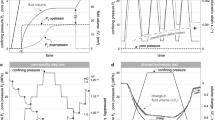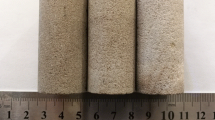Abstract
Effective stress is one of the most important parameters which strongly affects pore volume compressibility curve, which is used in assessing the reservoir rock properties. It causes change in porosity as well as permeability of the reservoir rocks. In the present study, pore volume compressibility characteristics of the reservoir rocks at different effective stresses were used to derive the relationship of porosity and permeability with the effective stress. To this end, analytical processes for deriving the porosity–stress and permeability–stress relationships are discussed in relation to the reservoir rocks. As a result, a porosity–stress formulation is proposed which is in good agreement with the experimental data. Also, two formulas are proposed for permeability–stress relationship; one on the base of Kozeny–Carman permeability–porosity model and the other one is based on a differential form of permeability–porosity relationship. After calibrating the required coefficients for one sandstone and three limestones, it was concluded that the first permeability–stress model is the upper bound correlation while the latter is the lower bound. Furthermore, it is shown that the latter has better agreement to the real experimental data of the sansdstone samples, while the first one is close to the experimental observations from limestone samples. Also, it is concluded that structure of pores is a key factor on permeability–stress relationship, so that there is a significant difference between the experimental data and the proposed relationship for a limestone sample with vuggy pore spaces.





Similar content being viewed by others
References
Aloki Bakhtiari H, Moosavi SA et al (2011) The effect of rock types on pore volume compressibility of limestone and dolomite samples. Geopersia 1:37–46
Bernabé Y, Brace WF, Evans B (1982) Permeability, porosity and pore geometry of hot-pressed calcite. Mech Mater 1:173–183
Bernabé Y, Mok U, Evans B (2003) Permeability–porosity relationships in rocks subjected to various evolution processes. Pure Appl Geophys 160:937–960
Bia M, Elsworth D (2000) Coupled processes in subsurface deformation, flow, and transport. ASCE, USA
Carman PC (1937) Fluid flow through granular beds. Trans Inst Chem Eng 15:150–166
Carman PC (1957) Flow of gases through porous media. Butterworths, London
Chen WF, Han DJ (1988) Plasticity for Structural Engineers. Springer, 1st Ed
Civan F (2000) Reservoir formation damage. Gulf, Houston, Texas, p 742
Coyner KB (1984) Effects of stress, pore pressure, and pore fluids on bulk strain, velocity, and permeability of rocks. Ph.D. thesis, Massachusetts Institute of Technology, Cambridge, MA
Davies JP, Davies DK (2001) Stress-dependent permeability: characterization and modeling. SPE 71750:224–235
Fatt I (1958) Pore volume compressibilities of sandstone reservoir rocks. Petroleum Tran Sactioss, AIME
Fatt I, Davis DH (1952) Reduction in permeability with overburden pressure. Trans AIME 195:329
Ghabezloo S, Sulem J et al (2009a) Effective stress law for the permeability of a limestone. Int J Rock Mech Min Sci 46(2):297–306
Ghabezloo S, Sulem J et al (2009b) Evaluation of a permeability–porosity relationship in a low-permeability creeping material using a single transient test. Int J Rock Mech Min Sci 46(4):761–768
Gobran BD, Brigham WE, Ramey HJ (1987) Absolute permeability as a function of confining pressure, pore pressure, and temperature. SPE 10156. SPE Form Eval 11:77–84
Hall HN (1953) Compressibility of reservoir rocks. Pet Trans AlME 198:309–311
Han G, Dusseault MB (2003) Description of fluid flow around a wellbore with stress-dependent porosity and permeability. J Petrol Sci Eng 40(1–2):1–16
Harari Z, Wang Sh T, Saner S (1995) Pore-compressibility study of Arabian carbonate reservoir rocks. SPE 27625, SPE Formation Evaluation, 207–214
Iscan AG, Kök MV et al (2006) Estimation of permeability and rock mechanical properties of limestone reservoir rocks under stress conditions by strain gauge. J Petrol Sci Eng 53(1–2):13–24
Jalalh A (2006) Compressibility of porous rocks: Part I. Measurements of Hungarian reservoir rock sample. Acta Geophys 54(3):319–332
Khan AS, Huang S (1995) Continuum theory of plasticity. Wiley-Interscience, 1st Ed
Kok MY, Iscan AG, Ulker EB (2002) Effect of axial stresses on reservoir rocks. Energy Sources A Recover Utilization Environ Eff 24(10):915–920
Koutsabeloulis NC, Hope SA (1998) Coupled stress/fluid/ thermal multi-phase reservoir simulation studies incorporating rock mechanics. SPE 47393, Eurrock, Conference Proceedings: 449–454
Kozeny J (1927) Ueber Kapillare Leitung des Wassers im Boden. Sitzungsber Akad Wiss Wien 136:271–306
Li Ch, Chen X, Du Z (2004) A new relationship of rock compressibility with porosity. SPE 88464 presented at SPE Asia Pacific Oil and Gas Conference and Exhibition held in Perth, Australia, 18–20
Liu H-H, Rutqvist J, Berryman JG (2009) On the relationship between stress and elastic strain for porous and fractured rock. Int J Rock Mech Min Sci 46(2):289–296
Lucia FJ (1983) Petrophysical parameters estimated from visual description of carbonate rocks: a field classification of carbonate pore space. J Pet Technol, March: 626–637
Lucia FJ (2007) Carbonate reservoir characterization, an integrated approach. 2nd Ed., Springer
Luo R, Feng J (2009) Deformation characteristics of low permeability rocks under confining pressure. Flow in porous media—international forum on porous flow and applications, Wuhan City, China, 21–26.
Mohiuddin MA, Korvin G, Abdulraheem A, Awal MR, Khan K, Khan MS, Hassan HM (2000) Stress-dependent porosity and permeability of a suite of samples from Saudi Arabian sandstone and limestone reservoirs. SCA2033, 2000 Symposium of Core Analysts, Abu Dhabi, UAE
Newman GH (1973) Pore-volume compressibility of consolidates, friable, and unconsolidated reservoir rocks under hydrostatic loading. J Petrol Technol 25(2):129–134
Ramm M (1992) Porosity-depth trends in reservoir sandstones: theoretical models related to Jurassic sandstones offshore Norway. Mar Pet Geol 9(5):553–567
Wang R, Yue X et al (2009a) Effects of time lag and stress loading rate on permeability in low permeability reservoirs. Min Sci Technol (China) 19(4):526–530
Wang XS, Jiang X et al (2009b) Evaluation of depth-dependent porosity and bulk modulus of a shear using permeability-depth trends. Int J Rock Mech Min Sci 46(7):1175–1181
Yale DP (1984) Network modeling of flow, storage and deformation in porous rocks. PhD dissertation, Stanford University, Standford, CA, USA
Zhang MY, Ambastha AK (1994) New insights in pressure—transient analysis for stress-sensitive reservoirs. SPE annual technical conference and exhibition, New Orleans, Louisiana, 25–28
Zheng Z (1993) Compressibility of porous rocks under different stress conditions. Int J Rock Mech Min Sci Geomech Abstr 30(7):1181–1184
Zimmerman RW (1991) Compressibility of sandstones. Developments in Petroleum Science 29. Elsevier, New York
Zimmerman RW, Somerton WH, King MS (1986) Compressibility of porous rock. J Geophys Res 91(B12):12765–12777
Acknowledgments
The authors would like to gratefully acknowledge core lab engineers and technicians of the Research Institute of Petroleum Industry for providing the experimental data.
Author information
Authors and Affiliations
Corresponding author
Rights and permissions
About this article
Cite this article
Moosavi, S.A., Goshtasbi, K., Kazemzadeh, E. et al. Relationship between porosity and permeability with stress using pore volume compressibility characteristic of reservoir rocks. Arab J Geosci 7, 231–239 (2014). https://doi.org/10.1007/s12517-012-0760-x
Received:
Accepted:
Published:
Issue Date:
DOI: https://doi.org/10.1007/s12517-012-0760-x




